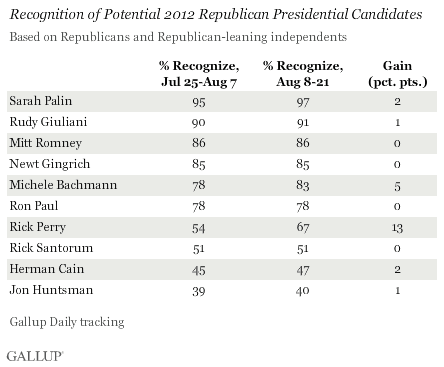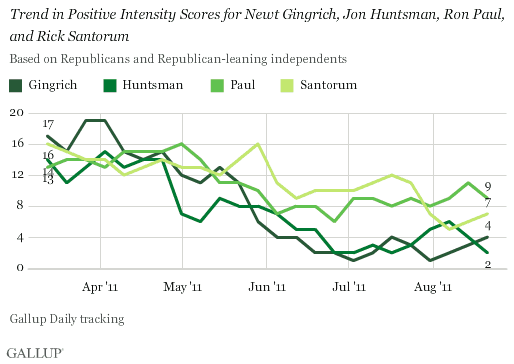PRINCETON, NJ -- Texas Gov. Rick Perry is now recognized by 67% of Republicans and Republican leaners nationwide, an increase of 13 percentage points from two weeks ago. Still, six of the other nine candidates or potential candidates are better known than Perry, led by Sarah Palin (97%) and Rudy Giuliani (91%). Of the announced candidates, Mitt Romney, Newt Gingrich, and Michele Bachmann are best known.

The latest results are based on Aug. 8-21 Gallup Daily tracking of 2012 Republican candidate images. Perry officially entered the race on Aug. 13. Prior to that announcement, 54% of Republicans were familiar with him. He is one of two candidates who have seen their recognition levels increase significantly over that time, a period that included the second candidate debate on Aug. 11 and the Iowa Straw Poll on Aug. 13. Bachmann, the winner of that straw poll, saw her recognition score increase five points.
As Perry has become better known over the past two weeks, his Positive Intensity Score has been stable in the low 20s -- now 22, compared with 23 two weeks ago. That score is based on the percentage of Republicans familiar with Perry who have a strongly favorable opinion of him minus the percentage with a strongly unfavorable opinion.
Perry's Positive Intensity Score is higher than all other Republicans' except Herman Cain's. Cain's 28 -- tied with his score from late May/early June -- is the highest Gallup has measured for any candidate this year. However, Cain has struggled to increase his familiarity to the GOP faithful, with 47% currently recognizing him. His recognition scores have not increased appreciably since mid-June, and his support on the Republican nomination ballot remains in the low single digits.
After Cain and Perry, the next-most-positively rated contender is former New York City Mayor Giuliani (+19), who is still considering entering the race but has not yet taken any formal steps to do so. Bachmann (+16), Romney (+14), and Palin (+14) also have scores above 10, while the remaining candidates are in single digits.

All of the candidates whose Positive Intensity Scores are in single digits -- Ron Paul, Rick Santorum, Gingrich, and Jon Huntsman -- have seen their scores decline over the course of the year. Paul's and Santorum's scores were at one time as high as 16, Huntsman's as high as 15, and Gingrich's as high as 19.

Tim Pawlenty experienced a similar decline in his Positive Intensity Scores, from a high of 17 in late March/early April to 7 at the time he exited the race last week.
Bachmann's score has been below 20 in four of the past five weeks after being 20 or above for most of the period from February to June.

Among the other active candidates, Romney has seen his Positive Intensity Score fluctuate between 13 and 20 this year; it has been holding at 14 or 15 in each of the last four weeks. Cain is the only candidate who has seen and maintained a generally upward trend in positive intensity, with scores no lower than 22 since early May.
Implications
Perry is off to a good start as a now-official candidate, seeing his familiarity among Republicans increase significantly in the last two weeks while maintaining a high Positive Intensity Score. The challenge for him is to keep that score up, now that he is actively campaigning. With that exposure comes the inevitable media scrutiny regarding his issue positions, personal qualities, and record for a broader audience, many of whom may not view them positively.
To date, Cain and Bachmann are the only candidates who have seen a rise in positive intensity as they became better known, although Bachmann's scores have declined in recent weeks as her recognition level has surpassed three-quarters of Republicans.
Survey Methods
Results are based on telephone interviews conducted as part of Gallup Daily tracking Aug. 8-21, 2011, with random samples of Republicans and Republican-leaning independents, aged 18 and older, living in all 50 U.S. states and the District of Columbia. Questions asking about the 10 potential candidates measured in this research were rotated among randomly selected samples of Republicans each night; over the 14-day period, each candidate was rated by approximately 1,400 Republicans and Republican-leaning independents.
For the overall ratings of each potential candidate among Republicans and Republican-leaning independents, including recognition scores, one can say with 95% confidence that the maximum margin of sampling error is ±3 percentage points. For the Positive Intensity Score for each candidate, the maximum margin of sampling error varies depending on the size of the group recognizing the candidate.
Interviews are conducted with respondents on landline telephones and cellular phones, with interviews conducted in Spanish for respondents who are primarily Spanish-speaking. Each sample includes a minimum quota of 400 cell phone respondents and 600 landline respondents per 1,000 national adults, with additional minimum quotas among landline respondents by region. Landline telephone numbers are chosen at random among listed telephone numbers. Cell phone numbers are selected using random-digit-dial methods. Landline respondents are chosen at random within each household on the basis of which member had the most recent birthday.
Samples are weighted by gender, age, race, Hispanic ethnicity, education, region, adults in the household, and phone status (cell phone only/landline only/both, cell phone mostly, and having an unlisted landline number). Demographic weighting targets are based on the March 2010 Current Population Survey figures for the aged 18 and older non-institutionalized population living in U.S. telephone households. All reported margins of sampling error include the computed design effects for weighting and sample design.
In addition to sampling error, question wording and practical difficulties in conducting surveys can introduce error or bias into the findings of public opinion polls.
For more details on Gallup's polling methodology, visit www.gallup.com.
